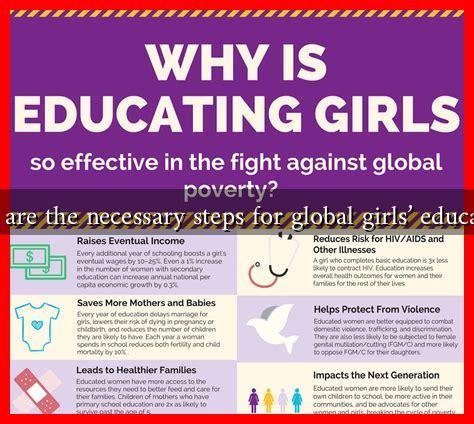-
Table of Contents
What are the Necessary Steps for Global Girls’ Education?
Education is a fundamental human right and a powerful tool for social change. However, millions of girls around the world are still denied access to quality education. According to UNESCO, approximately 130 million girls are out of school globally. This article explores the necessary steps to ensure that girls everywhere receive the education they deserve, highlighting the importance of community involvement, policy reform, and international cooperation.
The Importance of Girls’ Education
Investing in girls’ education has far-reaching benefits, not only for the girls themselves but also for their families, communities, and nations. Educated girls are more likely to:
- Become economically independent and contribute to their families’ incomes.
- Delay marriage and childbirth, leading to better health outcomes for themselves and their children.
- Participate in political processes and advocate for their rights.
- Break the cycle of poverty by educating the next generation.
According to a report by the World Bank, every additional year of schooling can increase a girl’s future earnings by up to 20%. This statistic underscores the economic imperative of investing in girls’ education.
Step 1: Community Engagement and Awareness
One of the first steps toward improving girls’ education is engaging local communities. Awareness campaigns can help shift cultural attitudes that prioritize boys’ education over girls’.
- Conduct community workshops to discuss the benefits of girls’ education.
- Involve local leaders and influencers to advocate for girls’ schooling.
- Share success stories of educated women who have positively impacted their communities.
For example, in rural India, the NGO Pratham has successfully increased girls’ enrollment in schools by working closely with communities to address cultural barriers and promote the value of education.
Step 2: Policy Reform and Government Commitment
Governments play a crucial role in ensuring access to education for girls. Policy reforms are necessary to create an enabling environment for girls’ education.
- Implement laws that mandate equal access to education for all genders.
- Provide financial incentives for families to send their daughters to school.
- Ensure that schools are safe and free from violence and discrimination.
Countries like Rwanda have made significant strides in girls’ education through government policies that promote gender equality in schools. The Rwandan government has implemented a policy that mandates a 50% female representation in all levels of education, which has led to increased enrollment rates for girls.
Step 3: International Cooperation and Funding
Global partnerships and funding are essential for scaling up girls’ education initiatives. International organizations, governments, and NGOs must collaborate to provide resources and support.
- Increase funding for education programs focused on girls.
- Support initiatives like the Global Partnership for Education, which aims to mobilize resources for education in developing countries.
- Encourage private sector involvement in funding educational initiatives.
The Malala Fund, co-founded by Nobel laureate Malala Yousafzai, is an excellent example of how international cooperation can drive change. The fund focuses on empowering girls through education and has supported projects in countries like Pakistan, Nigeria, and Afghanistan.
Step 4: Addressing Barriers to Education
Many girls face barriers that prevent them from attending school, including poverty, child marriage, and lack of transportation. Addressing these barriers is crucial for improving girls’ education.
- Provide scholarships and financial aid to low-income families.
- Implement programs that raise awareness about the negative impacts of child marriage.
- Improve infrastructure, such as building schools closer to communities.
In Bangladesh, the “Girls’ Stipend Program” has successfully reduced dropout rates by providing financial incentives to families who keep their daughters in school.
Conclusion
Ensuring global girls’ education requires a multifaceted approach that includes community engagement, policy reform, international cooperation, and addressing barriers to education. By taking these necessary steps, we can create a world where every girl has the opportunity to learn, grow, and thrive. The benefits of investing in girls’ education extend beyond individual lives; they contribute to healthier families, stronger communities, and more prosperous nations. As we move forward, it is imperative that we prioritize girls’ education as a global imperative, recognizing its potential to transform societies.
For more information on girls’ education initiatives, visit UNESCO’s Girls’ Education page.

